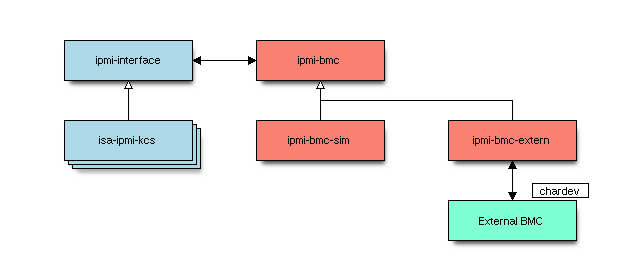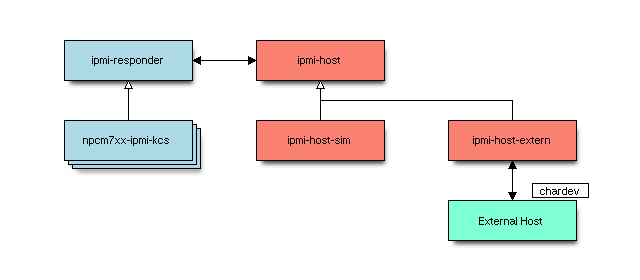IPMI device emulation¶
QEMU supports emulating many types of machines. This includes machines that may serve as the main processor in an IPMI system, e.g. x86 or POWER server processors, as well as machines emulating ARM-based Baseband Management Controllers (BMCs), e.g. AST2xxx or NPCM7xxx systems-on-chip.
Main processor emulation¶
A server platform may include one of the following system interfaces for communicating with a BMC:
A Keyboard Controller Style (KCS) Interface, accessible via ISA (
isa-ipmi-kcs) or PCI (pci-ipmi-kcs).A Block Transfer (BT) Interface, accessible via ISA (
isa-ipmi-bt) or PCI (pci-ipmi-bt).An SMBus System Interface (SSIF;
smbus-ipmi).
These interfaces can all be emulated by QEMU. To emulate the behavior of the BMC, the messaging interface emulators use one of the following backends:
A BMC simulator running within the QEMU process (
ipmi-bmc-sim).An external BMC simulator or emulator, connected over a chardev (
ipmi-bmc-extern). ipmi_sim from OpenIPMI is an example external BMC emulator.
The following diagram shows how these entities relate to each other.

IPMI System Interfaces¶
The system software running on the main processor may use a system interface
to communicate with the BMC. These are hardware devices attached to an ISA, PCI
or i2c bus, and in QEMU, they all need to implement ipmi-interface.
This allows a BMC implementation to interact with the system interface in a
standard way.
IPMI BMC¶
The system interface devices delegate emulation of BMC behavior to a BMC
device, that is a subclass of ipmi-bmc. This type of device is called
a BMC because that’s what it looks like to the main processor guest software.
The BMC behavior may be simulated within the qemu process (ipmi-bmc-sim) or
further delegated to an external emulator, or a real BMC. The
ipmi-bmc-extern device has a required chardev property which specifies
the communications channel to the external BMC.
Baseband Management Controller (BMC) emulation¶
Note
This section is just a proposal. QEMU does not yet support BMC-side IPMI emulation.
This section is about emulation of IPMI-related devices in a System-on-Chip (SoC) used as a Baseband Management Controller. This is not to be confused with emulating the BMC device as seen by the main processor.
SoCs that are designed to be used as a BMC often have dedicated hardware that allows them to be connected to one or more of the IPMI System Interfaces. The BMC-side hardware interface is not standardized, so each type of SoC may need its own device implementation in QEMU, for example:
aspeed-ipmi-ibtfor emulating the Aspeed iBT peripheral.npcm7xx-ipmi-kcsfor emulating the Nuvoton NPCM7xx Host-to-BMC Keyboard Controller Style (KCS) channels.

IPMI Responder¶
The software running on the BMC needs to intercept reads and writes to the system interface registers on the main processor. This requires special hardware that needs to be emulated by QEMU. We’ll call these device IPMI responders.
All IPMI responder devices should implement the ipmi-responder interface
to allow an IPMI Host implementation to interact with them in a standard way.
IPMI Host¶
Mirroring the main processor emulation, the responder devices delegate
emulation of host behavior to a Host device that is a subclass of
ipmi-host. This type of device is called a Host because that’s what it
looks like to the BMC guest software.
The host behavior may be further delegated to an external emulator (e.g.
another QEMU VM) through the ipmi-host-extern host implementation. This
device has a required chardev property which specifies the communications
channel to the external host. The wire format is the same as for
ipmi-bmc-extern.